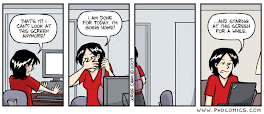
Optometry is the science that studies how vision works and its mission is preventing, detecting and solving the non-pathological visual upsets that a patient may present.
From refractive upsets (myopia, astigmatism, hyperopia…), all the way up to functional upsets (wrong focusing, visual system under visual stress, double vision sometimes,…), up to upsets happened during the development and the visual learning, not related to the fact of seeing in a clear and stable way, but to receive, understand, identify, discriminate size, shape and color, calculate distances and speed of objects, wrong eye-hand coordination, memorize,… I mean, any upset that impedes the achievement of the maximum visual performance with the minimum fatigue.
But really, in Spain my degree is known as Optic-Optometry; that is why I must point out that it has two inter-related fields of action.
• One physics side related to the study of the light in the vision, the lenses, the instruments used in Low Vision (they are optic aids for those people that have usually undergone a pathology or surgery, which has sufficiently reduced the clarity of the vision; those aids improve a little bit the quality of life), the optic materials and instruments, the manufacture of ophthalmic lenses (for glasses) and contact lenses, and so on.
• And another side related to the one above (because of the lenses that we use to correct a myopia or astigmatism, or the prisms for the strabismus), is the health side and it belongs to the area known as “Science of Health” (not Medicine); personally, I feel more identified with this side. This part studies:
- In one hand, how the light gets into the eye (creating myopias, hyperopias and astigmatisms). It is the part most related to physics.
- In another hand, how each eye works separately and together (whether they see clear, they focus right, they fuse well, …) to allow an optimum visual performance.
- At the end, how that light that gets in across the eyes, as visual information along with all information around it (auditory, tactile, vestibular,…), is integrated and processed neurologically to allow a good learning and an optimum general performance.
In Spain, this degree, is a three years “bachelor’s degree” that covers the following areas of knowledge: anatomy, biology, neurology, pharmacology, pathology, physiology, ergonomics, etc.; areas that for many people are in second place before the great field of the Optics (physics, chemistry, mathematics, geometric optics, instrumental optics, physic optics, etc.). When you graduate, and in order to be allowed to work lawfully, you need to sign on the Optics-Optometrist National Association (Colegio Nacional de Ópticos-Optometristas –CNOO-) compulsorily.
But in each country the educational period, the professional functions and the rules to execute the profession are slightly different. This creates a problem when you want to work in a different country than yours, since each one has its own “conditions”.
An optician-optometrist can specialize in diverse fields: Clinic Optometry, Contact Lenses, Child Vision, Geriatric Vision, Low Vision, Vision Therapy, Sports Vision, Neuro-optometry, Optometric instruments and Physic Optics.
In one hand, the History of Optics is very extensive. The ancient optics notions are unknown, but in the remains of Egyptian tombs, pieces of metallic mirrors were found, that probably came in useful for deflecting the sun rays. The Optics history narrates the history of the lenses, the discovery of the laws of reflection and refraction, and the formation of the images. It is interesting to know how the first optics instruments, like the telescope and the microscope, were invented, since most of the later optics instruments are modifications of these ones. If you are interested, the history is quite well explained chronologically in this link.
In the other hand, the History of Clinic Optometry and Vision Therapy in Spain has evolved along with the years (quite slower than in the US):
- In the University, the old curriculum (until 1995), we learnt a classic vision model, where most causes of visual problems are attributed to the genetics and the only solution to these problems are glasses or contact lenses, and surgery. This approach is a “victim model”, in which the patient is victim of the genetic, development or age-related changes, among others.
- Before the change of the curriculum occurred, a functional model came up approximately in 1985, where it was not just important seeing 20/20, but also that other visual problems can exist and where the solutions for these problems increase; checking that the visual skills can be developed through the use of techniques related to the oculomotor control, the improvement of focusing and the increase of fusional range from both eyes in a sequential and incremental way. Vision Therapy begins to arise. This approach is a “modified victim model”: the patient is victim of stress at near.
- In the new millennium the vision begins to be related to the rest of senses, integrated as a whole. A behavioral model comes up, where many visual and perceptual problems are related to a poor motor and neurological development. The visual problem is not caused due to the stress at near, but because people respond to that stress. The therapy is much more individualized because it depends on the individual needs, skills and goals of each person. It is not a procedure for improving the vision, but the conscience and the person, making internal changes in the individual that creates the improvement. The approach is a “no-victim model”: The patient knows what he does wrong and can modify his behaviour consciously, in order to, through those internal changes, improve his visual and general performance.
This last vision model is not so novel in USA; it is being developed since 1970 and it is the model that I have come to study right to its birthplace.






